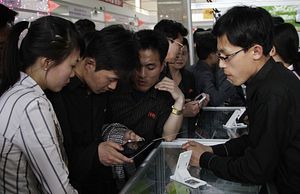Scientists and inventors across North Korea filled the latest Pyongyang Spring International Trade Fair with many new ideas. One scientist presented a design for a bullet train while another brought a design for a new type of air purifier.
For the North Korean government, the trade fair is an ideal place to boast about its latest achievements in advanced technologies in different fields including electronics, machinery, building materials, transport, public health, light industry, food, and even the consumer goods industry.
For outsiders, however, the fair is a venue where people can gauge how far North Korea’s scientific technologies have progressed. Technological developments in North Korea are often hidden behind a veil or only partially reported by state media outlets.
This year, delegations from a number of foreign countries — including China, Germany, Italy, and Iran — attended the fair.
Despite the country’s long-lasting isolation, reports indicate that scientific research and efforts to advance technology have been actively pursued in North Korea.
Analysts point out that this is mainly due to the North Korea leader Kim Jong-un’s desire to boost the country’s economy through advanced scientific technologies.
Speaking at a forum last year, Kang Ho-je, a director of the North Korean Institute of Science and Technology, said North Korea’s policy on science and technology this year will be aimed at strengthening cooperation between production and scientific research institutes, putting emphasis on the localization of raw materials, fuel, and equipment.
Byun Hak-moon, a researcher at the institute, also said that the signs are evident at higher educational institutions in North Korea.
He cited several prestigious universities in North Korea, including Kim Il-sung University, as saying that they expanded the term of compulsory education from 11 years to 12 years and designated the year of 2017 as the “year of science education.”
In addition, the North Korean government has provided material assistance to the scientific community by constructing apartments and department stores exclusively for their use. It is also expanding its research institutes in advanced fields such as nanotechnology while encouraging its joint research with overseas students, according to Byun.
Byun noted that North Korea is encouraging the commercialization of research institutions and university research achievements, and it appears that the private transfer of technology from the defense side is also underway.
One study backs this trend up. According to Korea Institute of Science and Technology Information (KISTI), the number of scientific papers published by North Korean researchers between 2012 and 2016 has increased substantially.
During this period, North Korean scientists published a total of 396 international scientific papers. In 2012, when Kim Jong-un took power, the number of publications increased more than threefold year-on-year.
The institute noted that there has also been an increasing number of papers by North Koreans through international joint research. Between 2012 and 2016, there were 60 independent papers published by North Korea, while 336 were written through international joint research.
Choi Hyun-kyu, who spoke at the same forum as the above-mentioned Kang and Byun, had a different view, however.
“Although North Korea has a strategy to enhance economic development with achievements in science and technology, it seems impossible to realize this goal given the capabilities that the North has shown so far,” said Choi.
“Developing the economy and nuclear power, or Byungjin policy, is clearly in North Korea’s permanent strategies to run the country. It seems to be rather spending more resources on developing military-related technologies,” he added.
The latest study by National Research Foundation of Korea (NRF) also noted that there has been no obvious significant leap forward in North Korea’s scientific research in the last five years. North Korea only publishes about 20 papers per year on average, and its joint research with China was limited, according to NRF.
Nonetheless, North Korea’s efforts are still underway. For example, North Korea’s Central Information Agency for Science and Technology has released a new program, which allows users to check new science technologies developed by other nations.
The program, dubbed Key 1.0, provides scientific journals published by the Central Information Agency from 2010, according to North Korean propaganda website Arirang-Meari.
The program also offers news reports on new technologies published after 2017 and global scientific journals published after 2016, hinting at the hermit kingdom’s desire not to fall behind in scientific technologies on the global stage.
It might be wise to raise expectations for next year’s Pyongyang International Trade Fair.

































